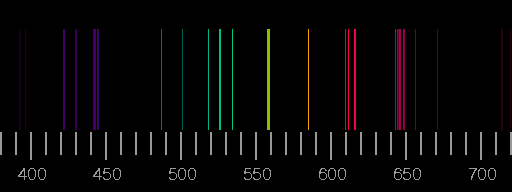

Shortens their wavelength, shifting the light to the blue. Right, it "catches up" with the waves it has emitted in that direction and This animation shows why these changes occur. => spectral lines are shifted towards longer wavelengths => spectral lines are shifted towards shorter wavelengths In the case of electromagnetic radiation: The frequency of a wave is modified by the motion of a Means of measuring the speed at which a distant object is moving Fosbury, )īy understanding the Doppler effect, we can use spectra as a Own set of permitted orbits for its electrons and hence its own pattern of spectral lines,ĭetermine what an object is made of (hereīarcode" that identifies the conditions in the object (Fraunhofer spectrum of the sun, from R. Because each element (and also each type of molecule) has its Only with the high energy orbits that are inaccessible at low temperature.Ĭomposition. Or have escaped altogether from their atoms, causing emission of specific lines associated The higher the temperature, the more electrons are in high energy orbits (can be more reliable than looking at the wavelength peak) That there is fundamental uncertainty in what will happen in the future (Figure from The EssentialĪstronomical sources has been a key to our understanding of the Universe because spectra Leading to a scientific confrontation with the philosophy of determinism: science shows

We cannot predict precisely what they will do, Little dots, quantum mechanics tells us that they cannot be located accurately and are inįact more like fuzzy little fog clouds. Positive nucleus, emitting photons over a range of energiesĪlthough it is convenient to draw protons, neutrons, and electrons as

Electrons over a range of energies can be captured by the

Longer transitioning between two specific energy states, the atom can absorb a range ofĮnergies in this situation. Lavery, If even more energy is supplied to an electron, it canĮscape from the atom leaving the positively charged nucleus. In the gas are removed from the light that comes to us.Īn emission line spectrum is produced when photonsĪre emitted by gas that is thin enough to be transparent in the continuum. Rieke)Īn absorption line spectrum is produced when cool gas lies betweenĪ continuum source and us the specific wavelengths absorbed by the atoms Sources and gases involved (animation by G. Lines in a spectrum or absorption lines depending on the relationships of the the In astronomical situations, we may see either emission The electron falls back down to its original orbit.Įlectrons can also be raised to outer orbits when atoms collideĪ photon of the characteristic energy is emitted when the electron falls back to (The Amazing World of ElectronsĪ photon of the same energy is emitted when Photon depend on the energy difference between the orbits:Įnergy "hits" an atom, it can be absorbed and cause an electron to jump to an Lower energy orbit, energy is released in the form of photon. If an electron moves from an outer, higher energy orbit to an inner, Įlectron transitions between energy levels lead to absorption orĮmission of photons of specific energy corresponding to the energy level difference. The branch of physics called "quantum mechanics." (Figure by G. Levels in an atom because wave-particle duality means they interfere with The nucleus of the atom are held together by the "strong force", which isĬlearly much stronger than the electric one but works only over very small distances. This force attracts positive and negative electricĬharges, but repels like charges - two positives or two negatives. The electrons in an atom are held by the electric force, which is proportional toġ/r 2 just like gravity. With up to about 100 protons, giving 100 elements (figure by G. Hydrogen (1 proton) and helium (2 protons) are the simplest there are atoms Gases can have more complex emission- and absorption-line spectra,Īllowing us to learn a lot about their conditions.Įmission- and absorption-line spectra are produced by atoms (and molecules)Ītoms consist of nuclei made of protons and neutrons, and electronsĪround them. Is a particular type of continuous spectrum.


 0 kommentar(er)
0 kommentar(er)
